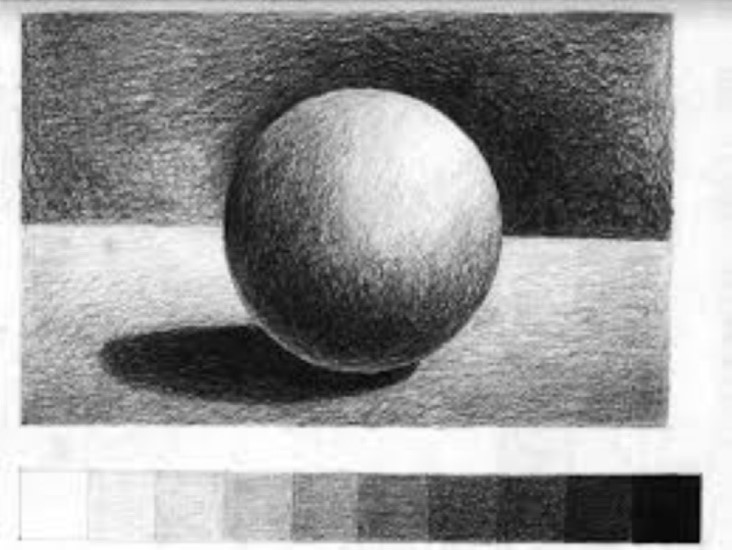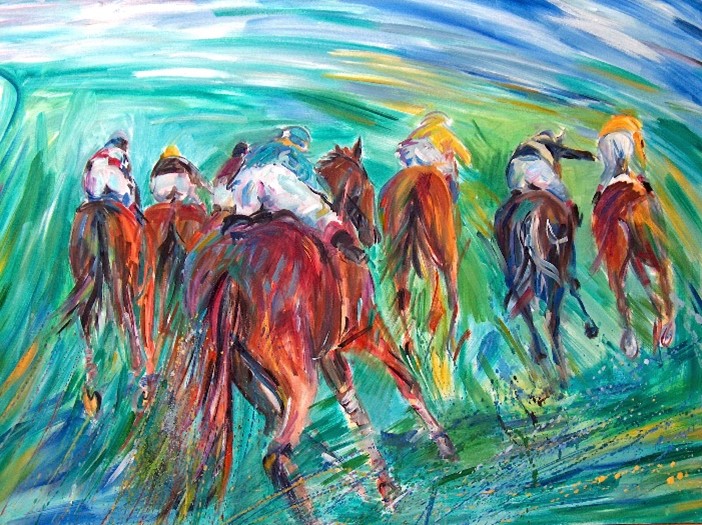In order to practice or critique visual art there are key concepts that art is built upon. Think of these as tools and building blocks and understanding and applying them is what gives the artist fluency and makes an art piece work. These elements and principles are the foundation of the language we can use to practice & talk about art.
15 Essentials
7 Elements: Line, Shape, Space, Form, Value, Colour, Texture
8 Principles: Rhythm, Harmony, Balance, Contrast, Movement, Pattern, Proportion, and Variety
The elements of art are the basics. They are the most important things to learn about art and are the visual tools that the artist uses to create a composition. They are like the basic ingredients for a recipe.
The principles of art are the underlying assumptions, laws or basic way in which something works. Whereas the elements are like the basic ingredients, the principles are like the methods used to help mould, shape or combine the elements. They can be used individually or in a variety of combinations depending on the style of the artist, the intent and desired effect. The use of these principles can help determine whether a painting is successful, and whether or not the painting is finished.
EXAMPLE IMAGE:
ELEMENTS OF ART:
Line, Shape, Space, Form, Value, Colour, Texture
LINE
Lines are marks made on a surface. Lines start at a point and move along, creating shape or space as they go. Every line has length, width/thickness and direction.
Lines can be straight, curved, uneven, implied, explicit, or gestural.
By varying the line, an artist can create movement, rhythm, movement, weight or suggest emotions. Lines can be two or three-dimensional where the marks describe the form itself or are implied or abstract. When you overlay lines that are parallel or angled to each other with more lines, it is a technique known as crosshatching. Crosshatching is used to indicate tone and shading. Contours line drawing can be suggestive.

Sketch by Gayle Grimsey –
Contour line drawing (abstract) of my hand while keeping my eye on my hand, not on what I am drawing on the paper.

Sketch using lines and crosshatching marks by Gayle Grimsey
(Reference photo of Rembrandt in ‘Drawing on the Right Side’ of the Brain by Betty Edwards)
SHAPE
Shape is usually an enclosed area. It is two-dimensional, flat, or limited to height and width.
Geometric shapes are squares, rectangles, triangles and circles. We see these in architecture and manufactured items. Organic shapes are free flowing, informal, natural, and abstract or have irregular characteristics. We see these in nature such as in trees, leaves, flowers, seashells etc. People are all shapes and sizes.
SPACE
Space is the element of art through which both positive and negative areas are defined or a sense of depth is achieved in a work of art. A positive shape automatically creates a negative shape. Positive shapes in a drawing or painting are the solid forms, eg a tree. The negative shape is the space around the positive shape or the spaces in and between the objects. Space and distance can be achieved by using perspective and tonal values.

Image: Positive and Negative Shape/Space
(Here black is the positive shape, and white is the negative space around it)


Sketches by Gayle Grimsey – Reference Betty Edwards book.
(Here white is the positive shape and the darker tones around it are the negative space)

Space and distance created by perspective and tonal values by Caspar David Friedrich
FORM
When a shape acquires depth or volume and appears as three-dimensional, it takes on form.
Form in art and painting renders a three-dimensional shape in two dimensions. Volume includes height, width and depth. This is where geometric shapes like a circle becomes a sphere or a cylinder, or a square becomes a cube etc. Form can also be abstracted and free-flowing. Form can be defined by line, value or colour – whether explicit or implied and which provides the contour or volume of forms.

Image: Jug
VALUE / TONE
Value is the lightness or darkness of tones or colours. White is the lightest value or tone; black is the darkest. The value halfway between these extremes is called middle gray.
Value or tone can be harsh, subtle, gradual, dramatic, chiaroscuro (strong light on the subject with dark background), shadow, highlights, silhouette, or tonal patterns and shading.

Image: Sphere/ball – showing values and tones in black and white

Image: Value and tone created by use of line and shading.
(Techniques: stipple, crosshatch, scribble, shading, hatching)
COLOUR
Colour has 3 parts – hue, value and intensity.
Hue is the colour itself.
Value is the hue’s lightness or darkness and changes when white or black is added to it.
Intensity is the aspect of brightness and purity of a colour. High intensity colours are bold and bright. Low intensity colours are faint and dull.
Colour Wheel:
There are three primary colours – red, blue and yellow. From these 3 colours plus white, you can mix all the different colours and tones. Harmonious colours are similar and are close together on the colour wheel. Complementary colour schemes such as red-green, blue-orange & purple-yellow are opposite on the colour wheel and produce vibrant, clashing effects.
Colour can be represented realistically or artists can deliberately alter colour for emotional effects.
Basic Colour Wheel:

Making tints with complementary or opposite colours on wheel.

TEXTURE
Texture defines the way an art object or an element in a composition feels or looks as if it would feel if touched. It can also refer to the thickness of the painting or drawing marks.

PRINCIPLES OF ART:
Rhythm, Harmony, Balance, Proportion, Contrast, Movement, Pattern, and Variety
Principles are the means or methods an artist uses to organize or combine the elements within a work of art.
RHYTHM
Rhythm describes or indicates movement in an artwork. Rhythm is created by the repetition of elements that come together to create a visual tempo or beat.

Image: Starry Night by Vincent Van Gogh
HARMONY
Harmony is achieved when the elements of an artwork come together in a unified way. It is not chaos and it is not monotony. You can have harmony in art using colour, marks and forms. Certain elements can be repeated or subtle gradual changes used to make them look and feel similar and part of the whole piece.

Image: Bathers at Asnières by Georges Seurat, 1884
BALANCE
Balance is a way of combining elements to add a feeling of equilibrium or stability to an artwork.
Balance is also Implied through both proportion and/or the weight of an object. Symmetry and asymmetry can be used to create a sense of balance. Symmetry is where the elements used on one side of the picture/design are similar to that on the other side. Asymmetry – the sides are different but still look balanced. Radical – the elements are arranged around a central point and may be similar.


PROPORTION / SIZE
Proportion refers to the relationship of certain elements in an artwork to the whole and to each another.


Image: El Mundo De Cristina by Andrew Wyeth
CONTRAST
Areas of contrast are where a viewer’s eye are usually drawn to first. Contrast can be in value, colours, shapes, textures etc. It is the contrast of extreme dark and light placed together that demands attention.

Image: By John Lovett

Image: Painting by John Lovett
MOVEMENT
Movement is used to create the look and feeling of action in an artwork. It guides the viewer’s eye throughout an art piece. A sense of movement can be varied lines, repetition of elements, and gestural mark-making among many more.

Image: Painting by Iris Scott

Image: Dove by Gayle Grimsey

Image: Kirsten Harris Art
PATTERN
Pattern is the uniform repetition of an element of art or combination of elements. Anything can be turned into a pattern through repetition. Patterns often occur in nature, and artists
use similar repeated motifs (theme) to create pattern in their work.

Image: Nature motifs for repeat pattern by Debbie Powell


Images: Fish patterns by Spoonflower
VARIETY
Variety is the principle of art concerned with diversity. Variety is achieved by using different colours, sizes and shapes. Emphasis (contrast) is used to stress certain elements for variety. Distortion of shapes and sizes is another technique used to create variety. Maintaining balance and unity within an artwork is to be kept in mind.

Image: ‘Aquarel 6’ by Wassily Kandinsky
Reference:
This article ‘Elements and Principles of Art and Design’ is adapted by Gayle Grimsey from various sources including Courtney Jordan, Lisa Marker, John Lovett & Betty Edwards.
